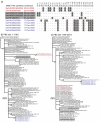No evidence for intra-segment recombination of 2009 H1N1 influenza virus in swine
- PMID: 22226809
- PMCID: PMC3427013
- DOI: 10.1016/j.gene.2011.10.041
No evidence for intra-segment recombination of 2009 H1N1 influenza virus in swine
Abstract
Hao (2011) reported that the PB2 genes of three swine influenza A viruses were likely generated through homologous recombination between two closely related parental strains. However, we show that Hao's observation is an artifact of incorrect taxon sampling arising through the lack of an appropriate evolutionary context. Through rigorous phylogenetic analyses we explain the evolutionary origins of these stains and confirm the lack of any statistical support for intra-segmental recombination.
Copyright © 2011 Elsevier B.V. All rights reserved.
Figures


Comment on
-
Evidence of intra-segmental homologous recombination in influenza A virus.Gene. 2011 Aug 1;481(2):57-64. doi: 10.1016/j.gene.2011.04.012. Epub 2011 May 6. Gene. 2011. PMID: 21571048 Free PMC article.
Similar articles
-
Evidence of intra-segmental homologous recombination in influenza A virus.Gene. 2011 Aug 1;481(2):57-64. doi: 10.1016/j.gene.2011.04.012. Epub 2011 May 6. Gene. 2011. PMID: 21571048 Free PMC article.
-
Evolution of influenza A virus PB2 genes: implications for evolution of the ribonucleoprotein complex and origin of human influenza A virus.J Virol. 1990 Oct;64(10):4893-902. doi: 10.1128/JVI.64.10.4893-4902.1990. J Virol. 1990. PMID: 2398532 Free PMC article.
-
Homologous recombination evidence in human and swine influenza A viruses.Virology. 2008 Oct 10;380(1):12-20. doi: 10.1016/j.virol.2008.07.014. Epub 2008 Aug 21. Virology. 2008. PMID: 18721995
-
[Swine influenza virus: evolution mechanism and epidemic characterization--a review].Wei Sheng Wu Xue Bao. 2009 Sep;49(9):1138-45. Wei Sheng Wu Xue Bao. 2009. PMID: 20030049 Review. Chinese.
-
Influenza A virus reassortment.Curr Top Microbiol Immunol. 2014;385:377-401. doi: 10.1007/82_2014_395. Curr Top Microbiol Immunol. 2014. PMID: 25007845 Review.
Cited by
-
Inferring the Clonal Structure of Viral Populations from Time Series Sequencing.PLoS Comput Biol. 2015 Nov 16;11(11):e1004344. doi: 10.1371/journal.pcbi.1004344. eCollection 2015 Nov. PLoS Comput Biol. 2015. PMID: 26571026 Free PMC article.
-
Reassortment in segmented RNA viruses: mechanisms and outcomes.Nat Rev Microbiol. 2016 Jul;14(7):448-60. doi: 10.1038/nrmicro.2016.46. Epub 2016 May 23. Nat Rev Microbiol. 2016. PMID: 27211789 Free PMC article. Review.
-
RNA Virus Reassortment: An Evolutionary Mechanism for Host Jumps and Immune Evasion.PLoS Pathog. 2015 Jul 9;11(7):e1004902. doi: 10.1371/journal.ppat.1004902. eCollection 2015 Jul. PLoS Pathog. 2015. PMID: 26158697 Free PMC article. Review. No abstract available.
-
Intragenic recombination influences rotavirus diversity and evolution.Virus Evol. 2020 Jan 13;6(1):vez059. doi: 10.1093/ve/vez059. eCollection 2020 Jan. Virus Evol. 2020. PMID: 31949920 Free PMC article.
-
Bioinformatics studies of Influenza A hemagglutinin sequence data indicate recombination-like events leading to segment exchanges.BMC Res Notes. 2016 Apr 15;9:222. doi: 10.1186/s13104-016-2017-3. BMC Res Notes. 2016. PMID: 27083561 Free PMC article.
References
-
- Gibbs MJ, Armstrong JS, Gibbs AJ. Recombination in the hemagglutinin gene of the 1918 “Spanish Flu”. Science. 2001;293:1842–1845. - PubMed
Publication types
MeSH terms
Grants and funding
LinkOut - more resources
Full Text Sources
Other Literature Sources

